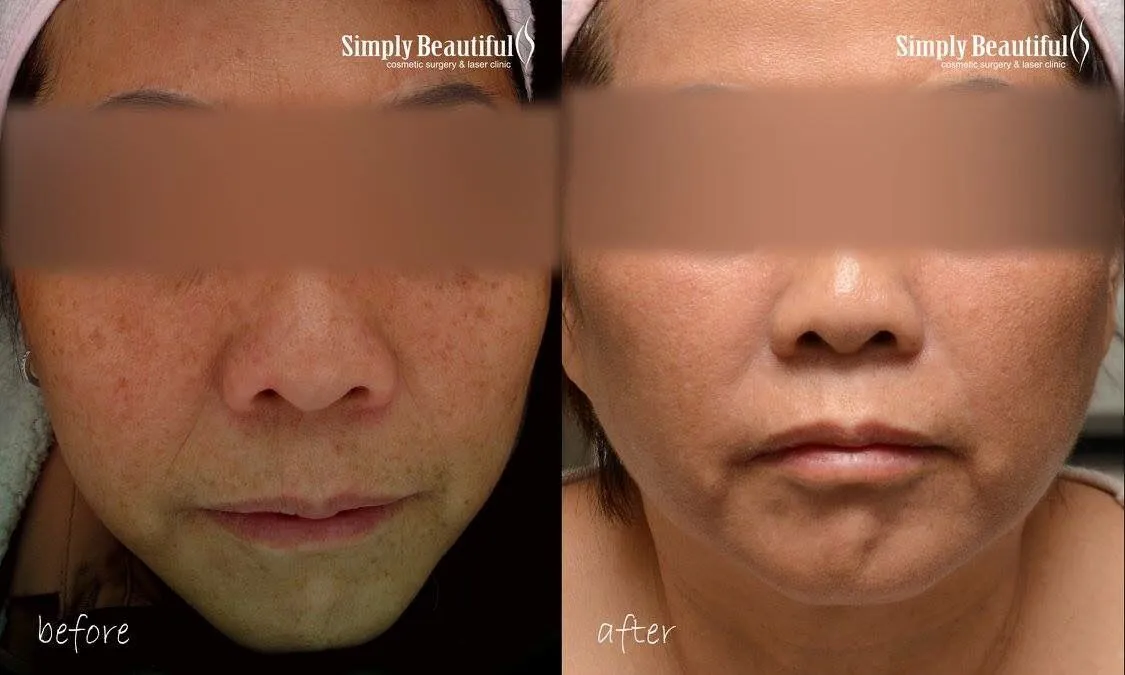What is Laser Skin Whitening
Laser skin whitening is a cosmetic procedure designed to reduce the appearance of dark spots, uneven skin tone, and hyperpigmentation, ultimately leading to a brighter and more even complexion. This treatment utilizes concentrated beams of light to target and break down melanin, the pigment responsible for skin color. By precisely targeting these areas, laser skin whitening aims to lighten the skin and diminish imperfections. This procedure has gained popularity as people seek effective ways to achieve a more youthful and radiant appearance. It’s a versatile treatment that can be applied to various parts of the body, including the face, neck, hands, and other areas affected by pigmentation issues.
How Laser Skin Whitening Works
The core principle behind laser skin whitening revolves around the selective targeting of melanin. Lasers emit specific wavelengths of light that are absorbed by the melanin in the skin. This absorption heats up the melanin, causing it to fragment into smaller particles. These fragmented particles are then naturally eliminated by the body’s immune system. This process gradually reduces the concentration of melanin in the treated areas, leading to a lighter and more even skin tone. The effectiveness of the treatment depends on the type of laser used, the individual’s skin type, and the specific skin condition being addressed. Multiple sessions are typically required to achieve optimal results.
The Science Behind Laser Skin Whitening

The science behind laser skin whitening involves photothermolysis, a process where light energy is converted into heat to damage specific targets without harming surrounding tissues. Different lasers emit different wavelengths, and the choice of laser depends on the target (melanin) and the skin type. The melanin absorbs the laser’s energy, which then shatters the pigment. The body’s natural processes remove the fragmented melanin. This precise targeting minimizes damage to the surrounding healthy skin. Advanced laser technologies also incorporate cooling systems to further protect the skin and enhance patient comfort during the procedure. Understanding the science of laser skin whitening is crucial for appreciating its effectiveness and safety.
Types of Lasers Used for Whitening
Several types of lasers are employed in skin whitening treatments, each with unique characteristics. The choice of laser depends on factors such as skin type, the severity of the pigmentation, and the specific skin concerns. Common types include Q-Switched lasers, and fractional lasers. These lasers offer varying levels of precision and effectiveness, allowing dermatologists to tailor the treatment to individual needs. The technology continues to advance, and newer laser systems are constantly emerging, offering improved safety and efficiency.
Q-Switched Lasers
Q-Switched lasers are among the most frequently used for skin whitening. These lasers deliver short pulses of high-intensity energy, making them highly effective at targeting melanin without causing significant damage to the surrounding skin. They are particularly well-suited for treating pigmented lesions, such as age spots, sunspots, and freckles. Q-Switched lasers come in different wavelengths, allowing practitioners to treat a range of skin tones and pigmentation issues. Their precision and effectiveness have made them a cornerstone in dermatological practices worldwide. (Image: q-switched-laser.webp)
Fractional Lasers

Fractional lasers deliver laser energy in small, targeted columns, leaving the surrounding skin intact. This technique promotes faster healing and reduces the risk of side effects. Fractional lasers are used for treating a variety of skin concerns, including pigmentation irregularities, fine lines, and wrinkles. By stimulating collagen production, these lasers also improve skin texture and tone. The precision and controlled nature of fractional lasers make them a popular choice for patients seeking both skin whitening and overall rejuvenation. (Image: fractional-laser.webp)
Benefits of Laser Skin Whitening
Laser skin whitening offers a range of benefits, extending beyond simply lightening the skin. It can significantly improve the overall appearance and health of the skin. From reducing hyperpigmentation to enhancing skin texture, the advantages are numerous. Laser treatments can boost self-esteem and confidence by addressing common skin concerns, making it a transformative procedure for many individuals. However, understanding the specific benefits in relation to individual needs is essential. The best way to understand if this is right for you, is to consult with a dermatologist.
Reduced Hyperpigmentation
One of the primary benefits of laser skin whitening is the reduction of hyperpigmentation. Lasers effectively target and break down excess melanin, which causes dark spots, sunspots, and uneven skin tone. This results in a clearer and more uniform complexion. The treatment can address various forms of hyperpigmentation, including post-inflammatory hyperpigmentation (PIH) and melasma. Patients often see a noticeable improvement in their skin’s appearance after a series of treatments, leading to increased confidence and satisfaction.
Improved Skin Tone and Texture

Laser skin whitening can dramatically improve skin tone and texture. The laser treatment stimulates collagen production, leading to smoother, more refined skin. This can help reduce the appearance of fine lines, wrinkles, and acne scars. By promoting skin cell turnover, laser treatments contribute to a healthier and more youthful complexion. The result is skin that looks and feels revitalized, with improved elasticity and a more radiant glow. Many patients report a significant enhancement in the overall quality of their skin.
Minimizing Fine Lines and Wrinkles
While laser skin whitening primarily targets pigmentation, it also helps minimize fine lines and wrinkles. The heat generated by the laser stimulates collagen production, which is essential for maintaining skin elasticity and firmness. As collagen production increases, the skin becomes tighter, reducing the appearance of wrinkles and fine lines. This makes laser skin whitening a versatile treatment option for those seeking both skin lightening and anti-aging benefits. The long-term effects of collagen stimulation contribute to a more youthful and rejuvenated appearance.
The Laser Skin Whitening Procedure
The laser skin whitening procedure involves several steps, from the initial consultation to post-treatment care. Understanding the process helps patients prepare and manage expectations. The procedure is typically performed by a qualified dermatologist or a trained professional. The duration of each session and the number of sessions required vary depending on the individual’s skin type and the extent of the treatment area. Adhering to pre- and post-treatment instructions is crucial for optimal results and to minimize the risk of complications. The process can be broken down into a consultation, the treatment itself, and aftercare.
Pre-Treatment Consultation

Before undergoing laser skin whitening, a thorough consultation is essential. The dermatologist will assess the patient’s skin type, medical history, and the specific skin concerns. This involves a detailed examination and discussion about the patient’s goals and expectations. The dermatologist will also explain the procedure, potential risks, and post-treatment care instructions. This consultation allows the dermatologist to determine if the patient is a suitable candidate and to tailor the treatment plan accordingly. It is an opportunity for the patient to ask questions and address any concerns. (Image: laser-skin-whitening-consultation.webp)
The Laser Session
During the laser session, the treatment area is first cleaned. Protective eyewear is provided to shield the eyes from the laser light. The laser device is then carefully applied to the skin, delivering controlled pulses of light. Patients may experience a mild sensation, often described as a snapping or tingling feeling. The duration of the session depends on the size of the treatment area, usually lasting from 15 minutes to an hour. After the session, the skin may appear slightly red or swollen, which typically subsides within a few days. (Image: laser-skin-whitening-procedure.webp)
Post-Treatment Care
Post-treatment care is critical for optimal results and to prevent complications. Patients are typically advised to avoid sun exposure and to use a broad-spectrum sunscreen with a high SPF. Gentle skincare products, such as mild cleansers and moisturizers, should be used. Following the dermatologist’s specific instructions is essential. This may include applying topical creams to aid healing and reduce inflammation. Patients should avoid picking or scratching the treated area to prevent scarring. Proper aftercare ensures the best possible outcome and supports the skin’s recovery process.
Side Effects and Risks

While laser skin whitening is generally considered safe, it is essential to be aware of potential side effects and risks. Understanding these factors helps patients make informed decisions and take appropriate precautions. Most side effects are temporary and resolve on their own. However, some risks can lead to more serious complications. Patients should discuss all potential risks with their dermatologist during the consultation to ensure they are fully informed. The overall goal is to maximize the benefits while minimizing the risks. (Image: laser-skin-whitening-side-effects.webp)
Common Side Effects
Common side effects of laser skin whitening include temporary redness, swelling, and mild discomfort in the treated area. Some patients may experience changes in skin pigmentation, such as temporary hyperpigmentation or hypopigmentation. Blistering and scabbing can also occur, but these are usually mild and resolve with proper care. Most side effects are temporary and typically subside within a few days to weeks. Following post-treatment instructions carefully can help minimize these side effects and promote faster healing. It is important to communicate any concerns with the dermatologist.
Risks and Complications
Although rare, more serious risks and complications can occur. These may include scarring, infection, and changes in skin texture. Hyperpigmentation or hypopigmentation can sometimes be permanent. Other potential complications include burns and allergic reactions to topical treatments. Choosing a qualified and experienced dermatologist and adhering to pre- and post-treatment instructions can significantly reduce the risk of complications. Discussing the potential risks during the consultation helps patients prepare and make informed decisions about the procedure.
Who is a Good Candidate for Laser Skin Whitening

Not everyone is a suitable candidate for laser skin whitening. The best candidates are those with specific skin concerns, realistic expectations, and a good understanding of the procedure. Factors like skin type, the nature of the pigmentation issues, and overall health are important considerations. Consulting with a dermatologist is essential to determine if this treatment is appropriate. This ensures that patients can achieve the best possible results while minimizing any potential risks. Evaluating these factors will help in creating the most effective treatment strategy.
Factors to Consider
Several factors determine whether someone is a good candidate for laser skin whitening. Skin type plays a crucial role, as certain skin types are more prone to side effects. The specific type and severity of pigmentation issues are important. Individuals should have realistic expectations about the results and a willingness to adhere to post-treatment care instructions. Medical history, including any existing skin conditions, must also be considered. A thorough consultation with a dermatologist is essential to assess these factors and develop a personalized treatment plan.
Skin Types and Laser Skin Whitening
Different skin types respond differently to laser skin whitening. Generally, individuals with lighter skin tones are better candidates, as the contrast between the pigment and the skin is more pronounced, leading to better results. Those with darker skin tones may require more cautious treatment and may be at a higher risk of side effects, such as hyperpigmentation. Dermatologists use different laser settings and techniques based on skin type. A careful assessment is crucial to ensure the safety and effectiveness of the treatment. (Image: laser-skin-whitening-before-after.webp)
Cost of Laser Skin Whitening

The cost of laser skin whitening varies depending on several factors, including the size of the treatment area, the number of sessions required, and the geographic location of the clinic. It is essential to understand the cost implications before undergoing the procedure. Patients should also consider the long-term benefits and the potential value of investing in this type of cosmetic treatment. Discussing the cost with the dermatologist during the consultation helps in making an informed decision. Comparing prices from different clinics is recommended to ensure a fair value.
Factors Influencing the Cost
Several factors influence the cost of laser skin whitening. The size and location of the treatment area are key determinants, as larger areas require more time and resources. The number of sessions needed to achieve the desired results also affects the overall cost. The type of laser used and the expertise of the dermatologist can also influence the price. Geographic location and the clinic’s reputation are also important considerations. Understanding these factors helps patients budget for the procedure and make informed choices about their treatment plan. (Image: laser-skin-whitening-cost.webp)
Tips for Choosing a Clinic
Choosing the right clinic is crucial for a successful laser skin whitening experience. Patients should carefully research clinics and dermatologists, considering their experience, qualifications, and patient reviews. Visiting the clinic and asking questions about the procedure and the equipment used is recommended. A reputable clinic will provide a thorough consultation and create a customized treatment plan. Following these tips ensures that patients receive safe and effective treatment. Taking the time to do proper research can significantly improve the overall experience and results.
Researching Clinics and Dermatologists
Thorough research is essential when choosing a clinic and dermatologist for laser skin whitening. Look for board-certified dermatologists with extensive experience in laser procedures. Check the clinic’s reputation and read patient reviews and testimonials. Verify the clinic’s credentials and ensure that it uses state-of-the-art equipment. Consider the clinic’s location, accessibility, and overall environment. A well-researched clinic will provide a safe, professional, and effective treatment experience. (Image: laser-skin-whitening-clinic.webp)
Reading Reviews and Testimonials
Reading reviews and testimonials from other patients is a valuable way to gauge the clinic’s reputation and the dermatologist’s expertise. Look for reviews that highlight the dermatologist’s skill, the clinic’s cleanliness, and the overall patient experience. Consider both positive and negative reviews to get a balanced perspective. Websites and social media platforms are great resources. Patient testimonials often provide insights into the effectiveness of the treatment and the level of care provided. Reading reviews will help you make a more informed decision.
Laser Skin Whitening Alternatives
Besides laser skin whitening, several alternative methods can help improve skin tone and reduce pigmentation. These alternatives offer different levels of effectiveness and may be suitable for individuals who are not ideal candidates for laser treatments or who prefer less invasive options. Exploring these alternatives allows individuals to make informed decisions about the most appropriate treatment for their needs. Consulting with a dermatologist helps determine the best approach.
Topical Creams and Serums
Topical creams and serums containing active ingredients such as hydroquinone, retinoids, vitamin C, and kojic acid can help lighten the skin and reduce pigmentation. These products work by inhibiting melanin production or promoting skin cell turnover. They are often used for mild to moderate pigmentation issues and can be purchased over-the-counter or prescribed by a dermatologist. The effectiveness of topical treatments depends on the concentration of the active ingredients and the frequency of use. Patience is necessary, as results typically take several weeks or months to appear.
Chemical Peels
Chemical peels involve applying a chemical solution to the skin to exfoliate the top layers, reducing the appearance of pigmentation and improving skin tone. Different types of chemical peels are available, ranging from light to deep peels, each with varying levels of intensity and downtime. Superficial peels can be performed with minimal downtime. Deeper peels offer more dramatic results but require a more extended recovery period. The choice of chemical peel depends on the severity of the skin condition and the desired outcome. Chemical peels are often a good alternative to laser skin whitening.
The Future of Laser Skin Whitening
The future of laser skin whitening promises continuous innovation and advancements in technology. Researchers are constantly exploring new laser wavelengths, techniques, and combinations of treatments to enhance the effectiveness and safety of the procedure. The goal is to achieve optimal results with minimal downtime and side effects. Advancements in laser technology are also leading to the development of more customized and targeted treatments, which can address specific skin concerns more effectively. The future of skin whitening will be characterized by more precision, better outcomes, and enhanced patient satisfaction.
In conclusion, laser skin whitening is a popular and effective cosmetic procedure for reducing hyperpigmentation and achieving a more even skin tone. By understanding the science behind the treatment, the different types of lasers available, and the benefits and risks involved, individuals can make informed decisions. Proper research, a thorough consultation with a qualified dermatologist, and adherence to post-treatment care are essential for optimal results and a safe, satisfying experience. As technology advances, the future of laser skin whitening looks promising, with potential for even more effective and personalized treatments. Consulting with a dermatologist is recommended to fully understand if laser skin whitening is the right path for you.
